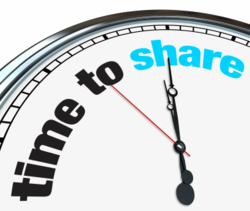
Get Your Share: 5 Easy Ways to Help Your Content Go Viral
Virality. You know what it is, but do you know how to get it? Sure, you’ve included references to LOLcats and #Linsanity in your most recent blog posts and emails, but perhaps you’re yet to have seen a lift in the sharing of your content. While it’s true that there’s no silver bullet for how to spark social sharing (though killer content is a great place to start), you may be overlooking some pretty simple ways to facilitate the spread of your content. Here are six things you can do today:
1) Strategic Button Placement
Including social sharing buttons with your content may seem like a no-brainer, but simply having them there isn’t always enough. Do a little exercise in design theory and put some thought into what button placement makes the most sense for your content’s layout. For example, if you have a banner across the top of your email and your main content doesn’t start until a bit further down, consider placing your social sharing buttons down there, right next to the content. The same rules apply for blog posts. Since most of your readers won’t decide to share something until after they’re done reading it (one would hope, at least), why put your buttons at the top where they’ll disappear as the reader scrolls down? Instead, place them at the bottom so that readers will be triggered to share as soon as they’re coming to the end. If you have the drive to get a little fancy with this, take a cue from Mashable and install a social share bar that scrolls down as you do:
2) Give ‘Em a Reason
With the seemingly never-ending stream of garbage great content that is social media, sometimes folks may need a little more convincing to pass your content on. Incentivizing sharing can be a great way to provide that extra push. While there are plenty of app companies out there that can provide you the tools to do a more complex sharing promotion (check out Offerpop, Wildfire, or North Social just to name a few), a simplified approach will do the trick more often than not. Simply determine an incentive (e.g., a free product or purchase discount), define the parameters of your campaign (e.g. the 10th sharer wins), and choose your social network. Note that this kind of promotion violates Facebook’s terms of service if you’re not using an app, but can be great on other networks like Twitter, Google+, or even Pinterest. Here, Simon & Schuster uses Twitter to offer a free copy of a book they’re promoting:
3) Do The Heavy Lifting
Sometimes people might be inclined to share your content, but have trouble figuring out what exactly it is about something that is most shareable. The longer your readers have to think about this, the less chance they hit that little Tweet button. While you might scoff at the logic behind this, realize that a share is a share and come to terms with the fact that some folks might need a little more handholding. Remember, it’s all about removing barriers here! One blog that does a phenomenal job of this is from our pals over at KissMetrics. Here they not only provide their readers with the HTML code to embed a graphic onto their own blogs, but they also provide a list of 140-characters-or-less tweetable stats:
4) Change the Channel
Perhaps you’ve been posting a lot of content to the network you spend the most time on (ahem, Facebook), but when it comes to that content being reshared all you hear is crickets. If this sounds familiar, it may be time to shake things up a bit and consider changing your distribution channel or adding others. Depending on your product or industry, niche communities may ignite more sharing. Addiionally, newer networks like Google+ and Pinterest that have more defined user demographics (tech crowd for G+, women for Pinterest) and don’t have the same level of saturation that more established networks do could be just the way get your content out there. Pinterest is a great example of this idea in practice. While social media’s new darling has far fewer active members than LinkedIn, Google+, and even MySpace, according to a new report from Shareaholic, Pinterest drives more traffic than all of these networks combined. Here we see an example of some infographics (see, it’s not all weddings and food porn!) that have truly gone viral on Pinterest:
5) Ask!
Possibly the most underused (and certainly easiest) way to prompt more sharing may also be the most obvious; just ask. Whether you’re asking for likes on a Facebook status update or RT’s on Twitter, you’d be surprised how often this simple call to action will actually work. On Twitter, just a simple “please” works wonders, as evidenced by John Haydon, a social media consultant for non-profits:
Asking for a share isn’t exclusive to Twitter, though. Take Facebook for example. Instead of just posting a link to a post on your blog, add a little context and encourage your fans to “like” the update for one reason or another. Remember that “likes” show up on Facebook timelines, so they are a great opportunity to get your content in front of a wider audience. Wildfire Interactive, a company that builds the kind of Facebook apps I touched upon earlier, does a fabulous job of this on their fan page:
Remember, nothing will ever trump genuinely good content when it comes to sharing, but like anything else, it never hurts to stack the deck in your favor. Ultimately, if you want your readers to share your content, you have to make it easy. Try testing these five ideas and let us know how they work for you!
© 2012 – 2018, Contributing Author. All rights reserved.




its just awesome point to get your content viral thanks man .